The next-gen MacBook Pro with Retina Display Review
by Anand Lal Shimpi on June 23, 2012 4:14 AM EST- Posted in
- Mac
- Apple
- MacBook Pro
- Laptops
- Notebooks
Last year when I wrote about the new MacBook Airs I offered two forward looking paragraphs:
What happens from here on out is what's really interesting. Intel has already committed to moving the TDP of its mainstream parts from 35W - 45W down to 10 - 20W. Since the Air is the new mainstream Mac notebook, Apple has already made that move. The performance in this 10 - 20W segment is going to get much better over the next two years, particularly once Haswell arrives.
The Thunderbolt Display is the first sign of what's to come. Moving IO controllers and expansion into the display, and potentially even moving discrete GPUs out of the notebook are all in store for us. Apple is really ahead of the curve here, but it's easy to imagine a future where laptops become a lot more like the new Air and shift to a couple high bandwidth ports instead of numerous lower bandwidth connections.
Perhaps I was being too aggressive in the prediction of a couple of high bandwidth ports. After all, the next-generation MacBook Pro with Retina Display features four such IO ports (2 x Thunderbolt and 2 x USB 3.0). But you get my point. Gigabit Ethernet and Firewire 800 are both gone. The discrete GPU is still present but I suspect even its days are numbered, at least inside the chassis. The personal computer as we knew it for so long, is changing.
The personal computer is getting thinner, lighter, more integrated and more appliance-like. The movement is no longer confined to just Apple either. The traditional PC OEMs are following suit. Even Microsoft has finally entered the PC hardware business, something it threatened to do for years but hadn't until now. Distribution models will change, the lines between different form factors will continue to blur. What was once a mature industry is going through a significant transformation. It’s exciting but at the same time it makes me uneasy. When I first got into this industry everyone had stories of companies with great ideas that just didn’t make it. As we go through this revolution in computing I’m beginning to see, first hand, the very same.
Apple makes the bulk of its revenue from devices that don’t look like traditional personal computers. For the past couple of years I’ve been worried that it would wake up and decide the traditional Mac is a burden, and it should instead be in the business of strictly selling consumer devices. With its announcements two weeks ago in San Francisco, I can happily say that my fears haven’t come true. At least not yet.
It’s been a while since Apple did a really exciting MacBook Pro launch. Much to my surprise, even the move to Sandy Bridge, the first quad-core in a MacBook Pro, was done without even whispers of a press conference. Apple threw up the new products on its online store, shipped inventory to its retail outlets, updated the website and called it a day. Every iPhone and iPad announcement however was accompanied with much fanfare. The MacBook Pro seemed almost forgotten.
With its WWDC unveil however Apple took something that it had resigned to unexciting, dare I say uncool status, and made a huge deal about it. Two weeks ago Apple did the expected and offered relatively modest upgrades to all of its portable Macs, all while introducing something bold.
Apple calls it the MacBook Pro with Retina Display. You’ll see me refer to it as the next-gen MacBook Pro, Retina MacBook Pro, rMBP or some other permutation of these words.
After using it for the past two weeks I can honestly say it’s the best Mac Apple has ever built. And there’s a lot more to it than hardware.
Portability
If you were hoping for a 15-inch MacBook Air, that’s not what the rMBP is. Instead it is a far more portable 15-inch MacBook Pro. I have to admit I was a bit let down the first time I laid eyes on the next-gen MacBook Pro, it looks good but it doesn’t look all that different. The disappointment quickly faded as I actually picked up the machine and started carrying it around. It’s not ultra light, but man does it make the previous chassis feel dated.
While I never really liked lugging around the old MBP (and it always made me feel like the old fogey at tradeshows where everyone else had something 13-inches or smaller), carrying the rMBP is a pleasure by comparison. Pictures really don’t do it justice. The impressively thin display assembly or overall chassis thickness look neat in a photo but it’s not until you actually live with the rMBP that you can appreciate what Apple has done here. I carry around a 15-inch MacBook Pro because it’s my desktop, and as such it’s incredibly useful to have with me when I travel. For my personal usage model, the Retina MacBook Pro is perfect.
If your workload demands that you need the performance of a MacBook Pro and your lifestyle requires you to carry it around a lot, the reduction in thickness and weight alone will be worth the upgrade to the rMBP. If you spend most of your time stationary however, you’ll have to be sold on the display and internal characteristics alone. The bad news is if the design doesn’t get you, everything else will.

From left to right: 11-inch MacBook Air, 13-inch MacBook Air, 15-inch MacBook Pro, MacBook Pro with Retina Display
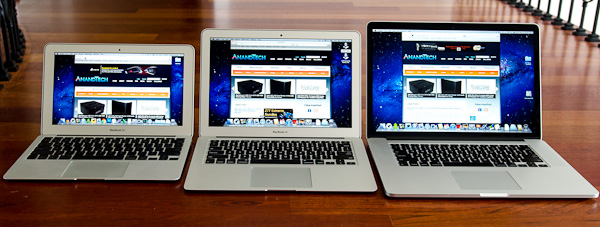
From left to right: 11-inch MacBook Air, 13-inch MacBook Air, MacBook Pro with Retina Display
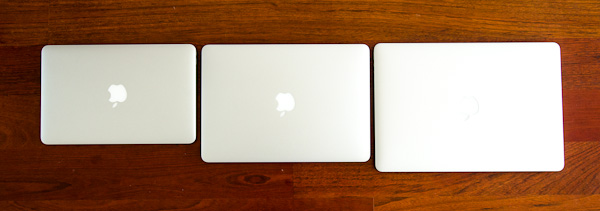
From left to right: 11-inch MacBook Air, 13-inch MacBook Air, MacBook Pro with Retina Display


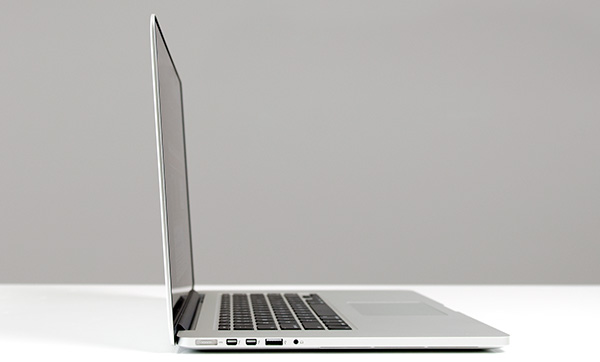
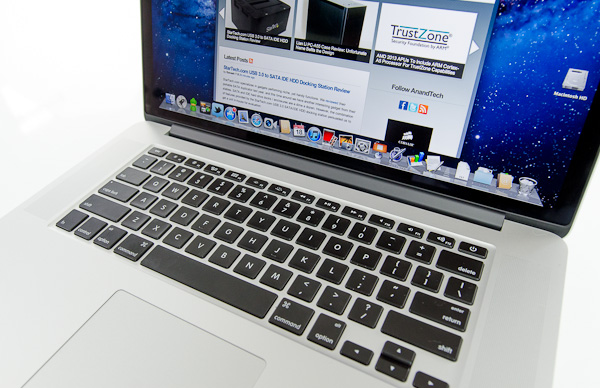
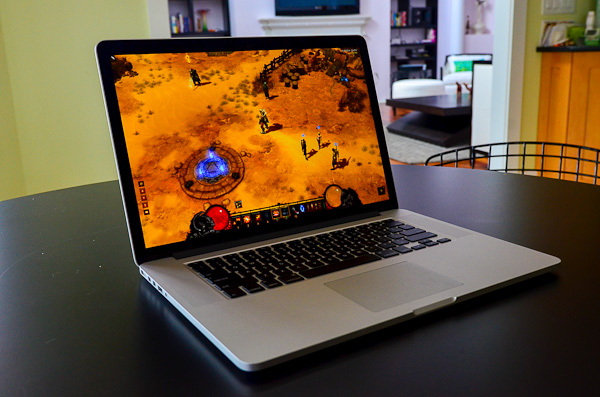
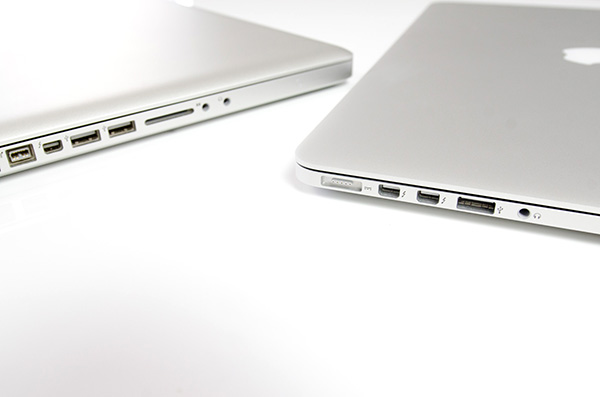
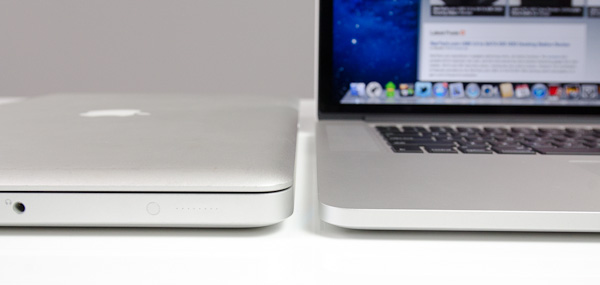








471 Comments
View All Comments
solipsism - Saturday, June 23, 2012 - link
Yes. They've been using them for awhile. At least from last year's MBA's, too.This screenshot is from the new RMBP.
• http://i.imgur.com/ACyGj.png
felixneo - Saturday, June 23, 2012 - link
the question was about the drives themselves, not the chipset.and the previous generation ssd's were too slow to compete with OWC offerings but at a higher price.
felixneo - Sunday, June 24, 2012 - link
so, does anyone have solid evidence that in the non retina macbook pro 15 2012 the optional ssd's are 6g units?MrCromulent - Saturday, June 23, 2012 - link
So how's the performance in multi-monitor setups? We've all seem the OWC blog post with the rMBP driving four displays which at first seems impressive... but if scrolling on *one* screen is sub-30fps already, how much worse does it get with three more displays?Good review as always.. though I miss surface temperatures and objective noise levels.
tipoo - Sunday, June 24, 2012 - link
I'd like to know that also. Doesn't sound good if you can already only scroll a page at 20-30fps, with two, three or even four monitors that would be worse.TEAMSWITCHER - Saturday, June 23, 2012 - link
"To truly take advantage of High DPI it seems as if Microsoft will need everyone to move to Metro."I sure hope this does't happen. I will not give up movable and resizable windows on a large format display for resolution independence. If this this is Microsoft's grand plan, I will abandon the Windows platform for the Mac. My Hackintosh-PC is already spending more and more time booted into OS X rather than Windows 7. For me the transition won't be difficult or costly.
DeciusStrabo - Saturday, June 23, 2012 - link
Just to think not being able to watch a video in one windows, have a live-blog/chat on the next and browsing/working in the main window causes me nightmares to be honest. It's a direction MS now moves with a lot of force I don't want to go to. That's actually the reason why I for the first time in 20 years consider buying a Macbook instead of a Windows laptop.Having a laptop that (which some caveats) is basically resolution-independent is very, very enticing too.
ananduser - Saturday, June 23, 2012 - link
Win7 will be supported until 2020. If you don't like staying on older software then by all means choose the post-PC mac.DeciusStrabo - Sunday, June 24, 2012 - link
As much as I like Win7, I don't want a situation like with XP where new technologies were eithe not supported orr supported via hacks and workarounds (TRIM, USB 3).Despite all the Skeuomorphism and iOS elements Apple's way of integrating the mobile and the desktop world under the leadership of the flexibility and feature-richness and UX of the dsektop approach appeals to me far more than MS' vision of bringing down laptops and desktops to the limited UX-niveau of mobile systems.
One example: The Windows-Filedialog was never the greatest thing, but has become very useable with Vista/Winows 7. Seeing that it might be replaced sooner or later with the DOS-like version implemented in Metro simply makes me sad.
DeciusStrabo - Saturday, June 23, 2012 - link
You are the first to mention beneath all the raving over the display the drawbacks it brings in terms of scrolling and lag. 20 fps doesn't sound that good to be honest. I'm now really reconsidering if I should buy the current MBPR or if I should wait a year until hardware catches up. 2300 € for a laptop that's not perfect? But the tech is rather enticing... Decisions, decisions.